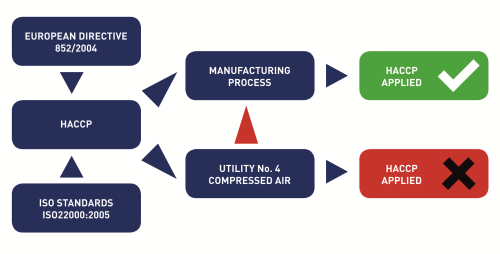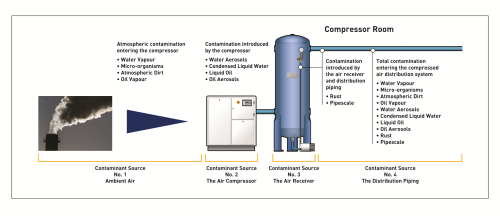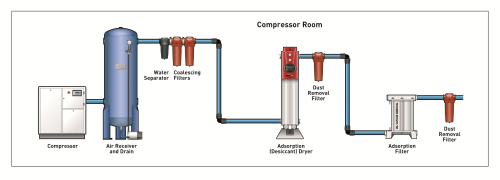


To protect consumers against ill health, most industrialised countries have initiated strict regulations and laws governing hygiene that must be adhered to during the preparation, processing, manufacturing, packaging, storage, transportation, distribution, handling and sale or supply of food products. Normally, regulations are strictly observed within the manufacturing and supply processes, but through lack of awareness, they are often not applied to utilities, most specifically compressed air supplies which power the manufacturing processes.
European hygiene regulations
Under European Regulation 852/2004, all European manufacturers of foodstuffs have a “duty of care” to protect the consumer. Article 5 of 852/2004 requires food business operators to instigate written food safety management systems (FSMS) based upon the principles of HACCP (Hazard Analysis Critical Control Point). In order to provide a more auditable means of implementing HACCP procedures, many companies are adopting standards such as ISO22000:2005.
ISO22000:2005
The ISO standard ISO22000:2005 fully endorses the principles of the HACCP system and by means of auditable requirements, combines the HACCP plan with prerequisite programs (PRPs). The standard states that hazard analysis is the key to an effective food or beverage safety management system.
Conducting a hazard analysis will assist in organising the knowledge required to establish an effective combination of control measures.
ISO22000:2005 requires that all hazards that may be reasonably expected to occur in the production chain, including hazards that may be associated with the type of process and facilities used, are identified and assessed.
Compressed air — The 4th utility
In most manufacturing scenarios, compressed air is often viewed as a utility and is therefore omitted from or overlooked in the hazard or risk analysis. Furthermore, many users are unaware of the contamination present in compressed air and the sources of that contamination, again leading to compressed air being omitted from the hazard analysis. In a typical manufacturing facility using compressed air, there are ten contaminants, which originate from four different sources, to consider. This contamination must be removed or reduced to acceptable levels for the compressed air to be suitable for use in food or beverage production.
Compressed air contamination and their sources
Understanding the sources of compressed air contamination and the types of contaminants which must be reduced or eliminated is a key factor in planning an efficient compressed air system. As previously stated, in a typical compressed air system, there are ten major contaminants that need to be removed or reduced to protect consumers, while ensuring a safe, efficient and cost effective production facility.
Source 1 – Atmospheric air
Compressors draw in and compress large volumes of atmospheric air, which continually fill the system with microscopic contaminants. These include: water vapour, atmospheric dirt, dust and pollen particles, oil vapour and micro-organisms.
Source 2 – The air compressor
In addition to the contaminants drawn in from the atmosphere, oil lubricated compressors will contribute small amounts of oil to the compressed air stream during the compression process.
This oil will be in the form of liquid oil, oil aerosols and oil vapours.
It should also be noted that although so called oil-free compressors will not directly inject oil into the air flow, they will still compress the same contaminated air as oil lubricated compressors, so that any oil vapours in the surrounding environment will still be compressed and passed into the downstream system.
After the compression stage, the after-cooler cools the air, which has the effect of condensing any water vapour and introducing it into the compressed air stream as liquid water or water aerosols.
Sources 3 and 4 – Compressed air storage devices and distribution piping
Compressed air storage devices or air receivers, together with the system distribution piping will also contribute contamination in the form of rust and pipe scale. Additionally, the compressed air storage and distribution system can contain large quantities of contaminants as well as providing an ideal warm and moist environment for the continuous growth of micro-organisms.
Hygiene and the HACCP principle
As the risks associated with compressed air contamination are not always apparent, it is not uncommon to find that the compressed air system and its usage points are overlooked when the HACCP hazard analysis (risk analysis) is carried out. In reality, every point in a food manufacturing plant where compressed air is used should be classified as a CCP (Critical Control Point), due to the contamination present in the compressed air system. Once classified as a CCP, measures must be taken to remove or reduce the contaminants to acceptable levels.
Sterility
Many applications within food manufacturing processes either require complete sterility or at least a level of control over the presence of micro-organisms. If contaminated compressed air is allowed to come into either direct or indirect contact with production equipment, ingredients, packaging materials, partially completed or finished products, then sterility is eliminated and control is lost.
Loss of sterility can cause enormous financial damage for a company. In particular, micro-organisms can lead to consumer health issues, while diminishing product quality, with for example reduced shelf life, or can render products entirely unfit for use, leading to recalls. These problems can lead to a loss of productivity, extra operating costs and, in a worst case scenario, potential legal action from consumer protection bodies.
It should not be forgotten that manufacturers also have a legal duty to protect their employees. It is therefore important to prevent contaminants such as water, particulate, oil and micro-organisms from being exhausted from pneumatic valves, cylinders, air motors and production equipment, as this can lead to an unhealthy working environment with the potential for personal injury, staff absences and financial compensation claims.
Finally, compressed air contamination will increase maintenance and operating costs, as moisture and dirt will lead to corrosion and wear on internal moving surfaces in cylinders and valves.
Compressed air contaminants and their removal
To many compressed air users, the realisation that there are ten major contaminants in a compressed air system can be something of a surprise. It is often thought that only three contaminants are present: dirt, water and oil. On closer examination, however, these three contaminants can be further categorised as follows:
Dirt
•Micro-organisms•Atmospheric Dirt and Solid Particulate•Rust•Pipe Scale
Water
•Water vapour•Condensed Liquid Water•Water Aerosols
Oil
•Oil Vapour•Liquid Oil•Oil Aerosols
It is important to consider each contaminant type in detail, as due to the diversity of the contamination present, a number of purification technologies must be employed for their removal.
The BRC/BCAS Food Grade Compressed Air Code of Practice
In the United Kingdom, to help manufacturers and ultimately protect the consumer from compressed air contamination, two major bodies have jointly developed a Code of Practice for Food Grade Compressed Air. These bodies are the British Retail Consortium (BRC), which represents the retail industry, and the British Compressed Air Society (BCAS), which is the UK governing body for compressed air.
This code evolved due to the absence of any compressed air quality standards or legislation for the food and beverage industries. The Code of Practice provides minimum purity or quality standards for compressed air and defines allowable levels for dirt, water and oil, in line with purity levels specified in ISO8573-1:2001, the international standard for compressed air quality.
Food Grade Compressed Air Code of Practice — Scope
The Code of Practice references complementary international standards for air purity, gives recommendations on testing and maintenance of compressed air systems, but most importantly, defines a minimum acceptable purity for compressed air used in the food and beverage industries.
The Code of Practice can be applied to the use of compressed air in all food and beverage manufacturing facilities, including bottling plants; however, it does not cover the quality of other gases used e.g. CO2 or N2 as these are often covered by other standards.
It is not mandatory to adopt the recommendations of the Code of Practice; however, following the Code of Practice allows a company to demonstrate due diligence should a ‘quality incident’ reach a court of law. Similarly, compliance with the Code of Practice is becoming a requirement by many UK retailers, with food and beverage producers being asked to show compliance with the Code of Practice if they wish to remain a supplier or prior to being accepted as a supplier.
The Code of Practice can also be applied to ingredient suppliers should they use compressed air in their production, transportation or packaging processes. Producers and suppliers located outside of the United Kingdom may also be required to demonstrate compliance with the Code of Practice, should their produce be sold to retailers in the UK.
The Code of Practice may also be adopted in other countries in the absence of any local standards or legislation. This will allow producers to demonstrate “Duty of Care” should a quality incident occur.
Practical solutions
Dealing with the compressed air before it enters the distribution system, as well as treating it at critical usage points with purification equipment, filters and air dryers is the most cost effective way for food manufacturers to eliminate contaminants and ensure that air quality complies with both the Code and Practice and current compressed air standards such as ISO8573-1:2010.
Coalescing filters are generally considered to be one of the most important items of purification equipment in a compressed air system, as they remove aerosols of water and oil, while offering the additional benefit of eradicating solid particulates and micro-organisms. For example, the latest generation of compressed air filters, such as the OIL-X EVOLUTION range from Parker domnick hunter, offers excellent performance, which exceeds ISO8573-1:2010 air quality standards, and has been validated independently by Lloyd's Register, the leading international approval authority. OIL-X EVOLUTION also uses innovative aerospace technology to optimise air flow paths and improve efficiency, enabling significantly reduced system operating costs to be achieved.
Coalescing filters are normally installed in pairs, in series, with one acting as a general purpose filter (Grade AO) and the other as a high efficiency filter (Grade AA), to ensure a continuous supply of high quality compressed air with low operational costs and minimal maintenance. It is important to remember, however, that filters do not remove all contaminants and that water vapour in particular must be removed using an appropriately specified compressed air dryer.
The latest advanced air dryers, such as Parker's PNEUDRI MX heatless dryers are compact, electronically controlled systems, capable of providing 100% standby drying capacity at a fraction of the cost of larger, conventional systems. Most critically, these dryers can be selected to deliver pressure dewpoints in accordance with ISO 8573-1:2010 Class 2 (standard), or Classes 1 or 3(optional) for water vapour and, when combined with the latest range of compressed air filters, can achieve Air Quality Classes 1.2.1, 1.1.1, or 1.3.1 respectively.
Due to the aseptic nature of many food and beverage applications, it is also essential to install sterile air filters at the point of use, with this and other associated downstream process equipment being in-situ sterilised regularly. Sterile air filters can also be tested for efficiency on a regular basis.
Once the purification equipment is in place, it is vital to perform regular system maintenance to ensure consistent air quality and compliance. In particular, the purification system must be serviced annually, as failure to do so will invalidate performance guarantees, potentially resulting in a range of problems, including reduced production performance, degraded air quality, possible product contamination and increased running costs.
By adopting a careful approach to system design, commissioning and operation, food manufacturers can ensure that they comply with both the BRC/BCAS Code of Practice and standards such as ISO 8573-1:2010, enabling them to demonstrate a high level of quality control, protection for consumers, while benefitting from reduced maintenance and operating costs.
Compressed air: Did you know?
•1m3 of ambient air can contain up to 100,000,000 micro-organisms, which are drawn into the compressor intake and end up in the compressed air system.•Micro-organisms grow rapidly in a compressed air system if left unchecked. Having a pressure dewpoint of better than −26°C will inhibit breeding or growth of micro-organisms.•Refrigeration dryers with a 3°C pressure dewpoint will not inhibit micro-organism growth (refrigeration dryers are commonly used due to their low cost). To inhibit growth, adsorption dryers with a dewpoint of −40°C pressure dewpoint should be used.•A typical 100KW compressor installed in the UK can introduce up to 70,000 litres of water a year into the compressed air system.•Oil-free compressors are not a prerequisite for the food & beverage industries. As the same amount of purification is required by both lubricated and non-lubricated compressors, lower cost, lubricated machines can be safely used with food grade lubricants.






